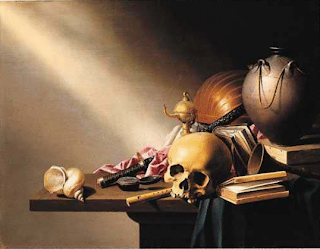-c.-1668.jpg)
The 17th century was a time of dramatic discovery, a time when the charting of unexplored worlds was a dream shared by adventurers and traders but by geographers and astronomers as well.
As James Welu has noted, Hendrick Hondius' terrestrial globe, which rests on the cabinet in its four-legged stand, is turned to reveal the Indian Ocean which may be a note of national pride. This route was taken by the Dutch to reach China and Japan. The text within the decorative cartouche on the lower right-hand side of the globe (illegible in Vermeer's paintings) reads in part: "Since very frequent expeditions are started every day to all parts of the world, by which their positions are clearly seen and reported, I trust that it will not appear strange to anyone if this description of the globe differs very much from others previously published by us ...we ask the benevolent leader, that if he should have a more complete knowledge of some place, he willingly, communicate the same to us for the sake of increasing the public good." The same terrestrial globe appears in Vermeer's later Allegory of Faith but with a very different allegorical meaning.
Mapmaking in the Netherlands during the 1500s and 1600s is noted for its works of lavish decoration, particularly the cartes à figures, whose ornamental panels depicted figures, landscapes and possessions. Most of the period's maps and atlases were the work of family businesses.
Fruit Bowl Research

The bowel which holds the fruit was commonly called a klapmut.
As the market for imported Chinese porcelain grew exponentially, oriental dealers shaped their products according to European tastes and needs. One of the striking hybrids was a large soup dish called the klapmuts, which drew its name from the shape of a cheap, wool hat worn by the lower classes. The low flattened shape of the klapmuts allowed the European to dip his spoon in the bowl with ease and then rest it on the bowl's wide-brimmed border. The Chinese drank their broth soups directly from a bowl with steep vertical sides and had no use for the European version.
I will need a bowl like this to display my fruit in, this i will buy from a charity shop or indoor market.


